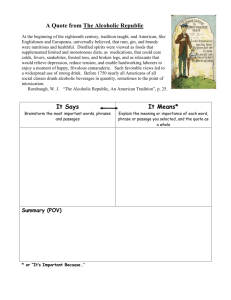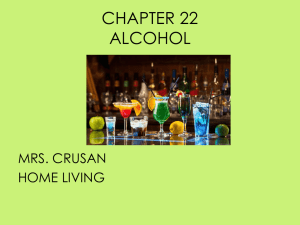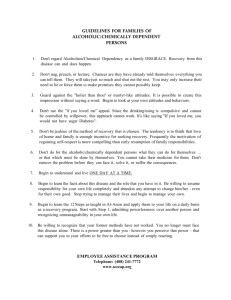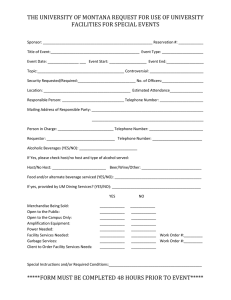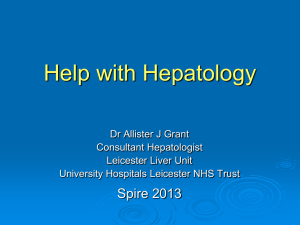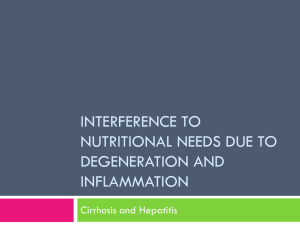Alcohol and the Liver
advertisement
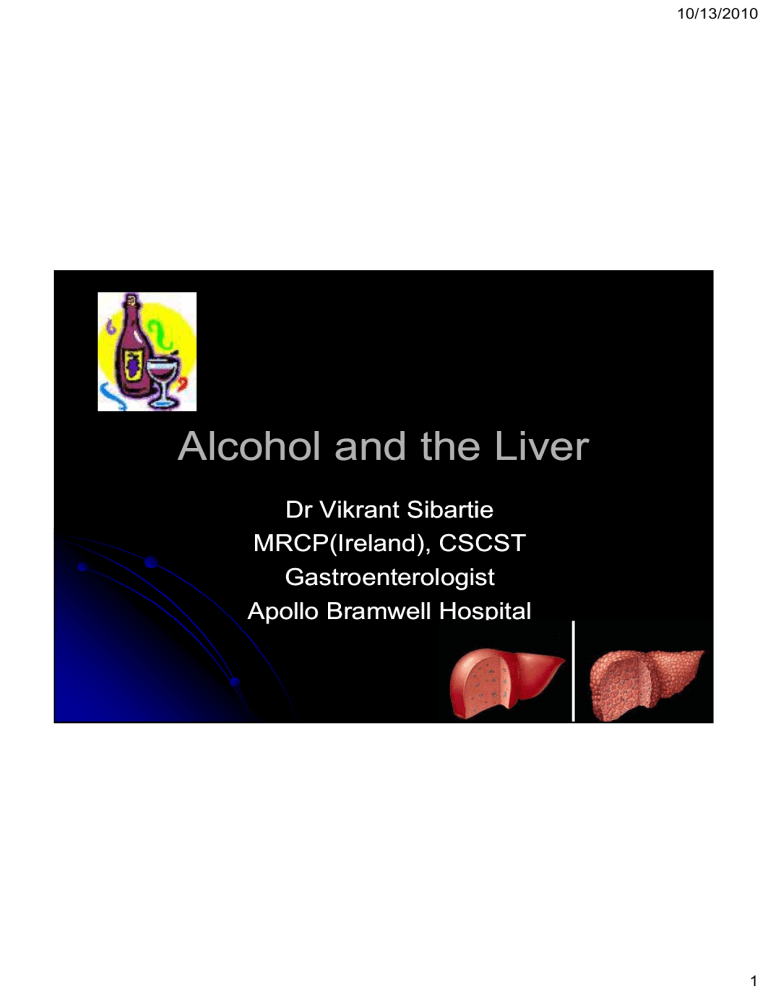
10/13/2010 Alcohol and the Liver Dr Vikrant Sibartie MRCP(Ireland), CSCST Gastroenterologist Apollo Bramwell Hospital 1 10/13/2010 Case presentation 36 yearyear-old man z Several previous admissions with alcoholalcoholrelated presentations z Drinks Di k 1b bottle ttl rhum/day rhum h /day /d z 2002: Delirium Tremens z 2003: Seizures z Jul 2007: Alcoholic hepatitis z Nov 2007: Alcoholic hepatitis z 2 10/13/2010 Admission 2009 Jaundice z Confusion Confusion-- encephalopathic z Ascites z Hypotensive Hypotensive,, BP=90/54 z Pyrexial z z Admitted to HDU 3 10/13/2010 Labs z z z z z z z z z z N 118 Na K 2.9 Urea 3.3 Creat 64 AST 85 ALT 58 GGT 570 Bili 375 Alk Phos 142 Albumin 24 Hb 10.1 10 1 Plt 148 WCC 13 INR 1.6 4 10/13/2010 Ascitic WCC=500/mm3, 90% neutrophils z IV Tazobactam/ Tazobactam/Piperacillin z IV Albumin z Worsening renal function z Urea=19.3 z Creatinine Creatinine=453 =453 (Day 15) z Oliguric despite being on IV Albumin and Terlipressin z 5 10/13/2010 Ongoing sepsis despite broadbroad-spectrum antibiotics z INR=2.1 z Worsening W i encephalopathy h l th d despite it Lactulose (NG tube) tube)-- becomes comatose z Ascites Ascites++ ++ z 6 10/13/2010 z z z Consensus after consultation with family, Anaesthesia and Renal medicine: Prognosis overall poor and dialysis would not g alter prognosis. Patient dies after 25 days 7 10/13/2010 Case 2 DL, 43 yearyear-old female z Drinks 80 units/week z Jaundice z Abdo pains z Nausea z Hepatomegaly z 8 10/13/2010 Day 1 z INR=1.3 z Bili Bili=116 =116 z Aphos Aphos=219 =219 z AST=217 z Alb=38 z GGT=142 z mDF mDF=11 =11 z Day 8 INR=1.5 Bili= Bili= 332 mDF=43 mDF=43 9 10/13/2010 Started on Pentoxifylline 400 mg TDS z NG feeding z Overall condition improves z Bili Bili=190, =190, INR=1.3 at discharge z 10 10/13/2010 11 10/13/2010 Background z z Alcoholism and ALD rife in developed societies, including Mauritius. Little wonder, as Man has been brewing and distilling alcohol since the Stone Age! 12 10/13/2010 Epidemiology Globally, 4% of the burden of disease and 3.2% of all deaths attributable to alcohol (WHO) z Encompass injury injury, violence, violence disease(ALD), social problems and highhighrisk behaviour. z Alcohol is a factor in 25% of A&E attendances in large Irish city hospitals. z 13 10/13/2010 14 10/13/2010 WHO Collaborative Study on Alcohol and Injuries 15 10/13/2010 WHO Collaborative Study on Alcohol and Injuries 16 10/13/2010 WHO Collaborative Study on Alcohol and Injuries 17 10/13/2010 Mauritius 18 10/13/2010 Heavy episodic drinkers ( 5 drinks or more per week in one sitting) 19 10/13/2010 Cause of death Mauritius 20 10/13/2010 Cases treated as inin-patients Brown Sequard hospital 2008 21 10/13/2010 Natural history of ALD Alcohol Normal liver Al h li Fatty Alcoholic F tt Li Liver (90-100%) (90 100%) Alcoholic Steatohepatitis (10-35%) Diet Genetics Obesity Female gender Hep C Haemochromatosis Alcoholic Cirrhosis (8-20%) HCC (1-2% p.a) 22 10/13/2010 Alcoholic steatosis z z z z z O Occurs invariably i i bl if alcohol l h l consumption>80 ti 80 g/day /d Present in 80% of heavy drinkers Hepatocyte cytoplasm occupied by triglyceride LFTs often normal Reversible with abstinence May progress to cirrhosis z 22% with alcoholic fatty liver developed cirrhosis after median 13 years Dam--Larsen et al. Scand J Gastroenterol 2005 Dam 23 10/13/2010 Alcoholic Fatty Liver - Histology 24 10/13/2010 Alcoholic Cirrhosis RR=13 for males drinking 60 g daily. For females: 40 g daily. z Survival in decompensated cirrhotics is 65% at one year and 35 35--50% at 5 years years. z Clinical presentation usually due to complications. z 25 10/13/2010 26 10/13/2010 Alcoholic Cirrhosis - Histology 27 10/13/2010 Alcoholic Cirrhosis – Clinical Features 28 10/13/2010 29 10/13/2010 30 10/13/2010 31 10/13/2010 32 10/13/2010 Acute Alcoholic Hepatitis 33 10/13/2010 Acute Alcoholic Hepatitis z S d Syndrome characterised h t i d by b pathological th l i l and d clinical features: z Jaundice Anorexia/ Weight loss Vomiting/ Fever Ascites Encephalopathy Gastrointestinal haemorrhage Hypoglycaemia Renal failure z z z z z z z 34 10/13/2010 Often deteriorate after stopping alcohol z 70 units per week z Women more susceptible z z 40 - 50% mortality 35 10/13/2010 Laboratory Findings z z z z Elevated bilirubin Prolonged prothrombin time Hypoalbuminaemia Modest elevation of transaminases z z z z z AST/ ALT ratio > 2 Thrombocytopaenia Neutrophilia Low urea Hyponatraemia 36 10/13/2010 Pathophysiology z Oxidative stress z z z Neutrophil infiltration and activation z z z z z Characteristic of alcoholic hepatitis IL--8 IL Inflammatory cell infiltration and activation z z Reactive oxygen species Induction of CYP2E1CYP2E1- generates oxidants COX-2 COXThromboxanes Cytokines- TNF CytokinesBacterial translocation (Gram negatives) 37 10/13/2010 38 10/13/2010 Histology Liver cell necrosis z Mallory bodies z Perivenular neutrophil infiltration z Steatosis z Fibrosis/Cirrhosis z 39 10/13/2010 Alcoholic Hepatitis 40 10/13/2010 Prognosis Morbidity zSepsis/SBP zMalnutrition zHepatorenal syndrome z 70% cirrhotic at presentation z 40 - 50% mortality z 41 10/13/2010 Genetics of ALD z Genes predisposing to alcohol abuse: ADH3, ADH 3, ALDH1A1 ALDH1A1ӿ ӿ2 z Genes protective against alcohol abuse: abuse: ADH1B,ADH1C, ALDH2 z Genes involved in generation of oxidant stress: CYP2E1, TNF TNF--α,SOD2,MAT1A,GST,Nrf ,SOD2,MAT1A,GST,Nrf--1 z Cytokine genes and receptors: receptors: IL--10,TNFIL 10,TNF-α,TNFRs z Genes encoding endotoxin receptors receptors:: CD14,NOD2,TLR4 Fibrosis genes: genes: CTGF,adiponectin,leptin,MMP,TIMP,collagens,DDX5 z 42 10/13/2010 43 10/13/2010 44 10/13/2010 45 10/13/2010 46 10/13/2010 Management z z z z z z Supervised by gastroenterologist Abstinence Alcohol withdrawal Nutrition Medications Other Rx z z z Ascites Encephalopathy Renal failure 47 10/13/2010 Nutrition z Enteral route preferred (No benefit with parenteral route) z z z z 2000 - 2500kcal daily 1 0 - 1.5g 1.0 1 5 protein/kg t i /k b bodyweight d i ht Thiamine/ Multivitamins/ Minerals In practice z z z U early Use l Safe May need nasogastric tube 48 10/13/2010 49 10/13/2010 Corticosteroids S Severe alcoholic l h li h hepatitis titi z DF > 32 z C/ I z z Bleeding z Sepsis Reduce short term mortality z No influence on progression to cirrhosis z Prednisolone preferred preferred-- 40 mg for 1 month z 50 10/13/2010 51 10/13/2010 52 10/13/2010 Pentoxifylline in ASH z P ti t with Patients ith severe ASH 28-day mortality (DF>32) z z 50 Double-blind,placeboDoubleblind,placebo-controlled Tx with 400 mg TDS for 28 days 45 40 p=0.037 35 z z z RESULTS Improved survival with PTX, mainly due to reduced hepatohepatorenal syndrome Reduced TNF TNF--α Effect exceeds expected benefit from steroids 30 % z 25 20 15 10 5 0 PTX CTR 53 10/13/2010 Hepato--Renal Syndrome Hepato z z z z z z Major criteria: Chronic or acute liver disease with advanced liver failure and portal hypertension Low GFR, as indicated by a serum creatinine of > 1.5 mg/dL mg/ dL (133 μmol/l) or a 24 24--h creatinine clearance < 40 mL/min mL /min Exclusion of shock, ongoing bacterial infection, volume depletion, and the use of nephrotoxic drugs No improvement in renal function despite stopping diuretics and volume repletion with 1.5 L of saline No proteinuria or ultrasonographic evidence of obstructive uropathy or parenchymal renal disease 54 10/13/2010 Minor criteria: criteria: z 1. Urine volume lower than 500 ml/day z 2. Urine sodium lower than 10 mEq mEq/L /L z 3. Urine osmolality > plasma osmolality z 4. Urine blood cells < 50 per highhigh-power fi eld z 5. Serum sodium concentration lower than 130 mEq mEq/L /L z 55 10/13/2010 Pathophysiology Increase in splanchnic vasodilation in cirrhosis z Activation of ReninRenin-Angiotensin system z Renal R l vasoconstriction t i ti ffrom sympathetic th ti nervous system activation. z All these lead to reduced renal perfusion and reduced GFR z 56 10/13/2010 HRS Type I: I: more serious type. z At least a 50 percent lowering of the creatinine clearance to below 20 mL mL/min /min in less than a two week period or at least a twofold increase in serum creatinine to a level greater than 2.5 mg/dL mg/dL (221 µmol/L). z Such patients often oliguric oliguric.. z 57 10/13/2010 HRS Type II :less severe renal insufficiency than that observed with type I disease. z Often characterized by ascites that is resistant to diuretics z 58 10/13/2010 Treatment Stop all diuretics z Exclude and treat sepsis, especially SBP z Volume expansion with IV Albumin ( 20 to 40 g per d day)) z IV Terlipressin (1 (1--2 mg 4 hourly) z 59 10/13/2010 Survival in Cirrhosis 60 10/13/2010 Conclusions Alcohol has a serious impact on society society-psychological, social and health. z 25% of A&E attendance alcoholalcohol-related. z Increasing I i pressures on healthcare. h lth z Poor access to residential detoxification programs. z Vicious Vicio s circle of patient readmission z More awareness at both public and political level needed for what is a growing public health problem z 61 10/13/2010 Thank You 62
